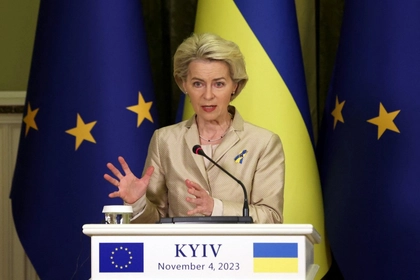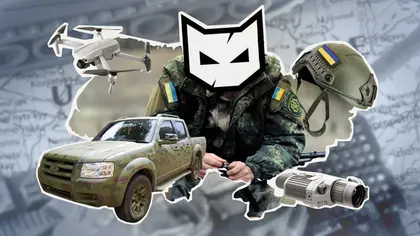Today, Ukrainian citizens are fighting for their sovereignty and a bright future on all fronts, trying to bring the country as close to victory as possible. In most cases, their efforts to assist are aimed at supporting the urgent needs of the military.
Automobiles, unmanned aerial vehicles, thermal imagers, communications equipment, tactical medicine items (first-aid kits, tourniquets, automatic defibrillators, et al.), ammunition, clothing and many other items of daily use for the military will remain in constant need until the war ends.
JOIN US ON TELEGRAM
Follow our coverage of the war on the @Kyivpost_official.
As a result, many civilians have become volunteers and help out in various fields. Some are civilians in the occupied territories, some have been wounded, and some are already engaged in restoring or providing temporary housing. However, the leading area of assistance is purchasing goods that are used directly at the front.
Being a volunteer can also be a dangerous activity. Items need to be delivered directly to the front line. Cases in which volunteers have met with serious injuries or even death are not isolated.
In addition, every day it is becoming increasingly difficult to find the funding for such valuable items as automobiles or thermal imagers. Society is exhausted and not everyone fully understands that items purchased for the military are not durable. For example, an automobile at the front will “live” for a maximum of two to three months. Medicinal items, on the other hand, are generally disposable, albeit indispensable.

EU Transfers €1.5 Bln Raised From Russian Assets for Ukraine
Kyiv Post spoke with Oleksandr Dubok, owner of the Armed Kit Foundation. It provides Ukrainian soldiers with weapons, ammunition and so-called dual-use goods.
Since the first day of the full-scale invasion, Dubok has been working hard to help provide the military with everything necessary in the shortest possible time. He even delivers aid to the war zone personally and has visited the hottest spots all along the front line.
The owner of the Foundation spoke about how the “volunteer kitchen” works inside, the current needs of the military, and some of his more dangerous experiences.
What areas do you work in and how do you find those who really need help?
Actually, we started with Kyiv. For some reason, on Feb. 24, 2022 I was unable to enlist for service, and on Feb. 25, weapons were not distributed. Still, I wanted to help, so I was engaged in providing food, necessary ammunition, and so on.
Since we mostly work with people we know personally, this circle started to expand gradually. The main thing is that we know that the help will really go to a good cause. So, our work has gone far beyond the borders of Kyiv.
We were in the Lysychansk, Severodonetsk sectors in the Luhansk region, in Kherson, then in the Kramatorsk, Slovyansk, and Bakhmut sectors in the Donetsk region. Now we also go to the border with Russia and Belarus and to the air defense units in the rear. Basically we help those who are directly engaged in defense.
My principled position is to deliver things on my own. First of all, this way I can learn about their real needs. For example, some fighters may be embarrassed to ask for help. Secondly, this means first-hand communication and new acquaintances with those who may need something.
What exactly do you provide for the military and what needs are relevant now?
We specialize in military items, because they are more complex and expensive. After all, feeding and dressing people is relatively inexpensive and easy. Moreover, there are a lot of concerned civilians who want to help with this.
Previously, we had a strategy – to help destroy as many Russian invaders as possible. That is, we were engaged in the purchase of sights, thermal imagers, drones, and so on.
Now we are changing direction slightly to protect the lives of our fighters. This means high-quality bulletproof vests and hard helmets, which are not very numerous right now. Also additional protection for the neck, stomach, back, sides, legs, etc.
I plan to start buying 15 such sets, the cost of one of them is approximately $1,600. That means about $25,000 for only 15 fighters.
I also want to make purchases in advance. After all, such needs are always relevant, like thermal imagers. No need to wait for someone to ask for help. Because by the time they ask, it was already needed yesterday. So it’s better to have such things in stock.
Of course, the state will provide this sooner or later. But time is of the essence, because people’s lives directly depend on it. And we bring it in quickly. For example, we can be near Bakhmut within a day.
In general, the Ukrainian state is not just the people in the Verkhovna Rada, but every person in the country. The state should provide for the military, but ordinary people are also the state.
What were the scariest moments you have experienced while working?
Although we only go out when we get permission from the military, various things do happen. For example, during our trip towards Lysychansk, we were shelled with a mortar. We then parked and heard two strikes behind us.
There was also a shell that hit the building where we spent the night. But it exploded, so the wall just crumbled where it hit. We were also at an oil depot in Lysychansk [Luhansk region] when the roof was hit by shells.
And our location closest to the Russians was in Toshkivka [Luhansk region], when they were about a kilometer away from us.
Incidentally, when we were going there, we were fired on with Grad multiple launch rocket systems, and when we returned from there, they aimed at us again.
What have you managed to buy during your volunteer work?
Before the new year, we officially registered as the “Armed Kit” charity organization. Then we summed up the results and found that if you count up the large equipment alone, it comes to more than $100,000.
In general, that includes 7 automobiles, 20 thermal imagers, 11 drones, more than 100 tactical first-aid kits, clothing, shoes, bulletproof vests, sights, boilers, generators, gas cylinders and much more. But we didn’t buy everything ourselves. Our policy is that if a certain person has funds, for example, for one thermal imager, then they can buy it and give it to us, and we will take it to the guys on the front line.
People can organize a fundraiser among their friends using the foundation’s banking details. Since the fund is officially registered, we also draw up the relevant documents on the spot – a protocol of acceptance and transfer of assets.
Do you earn a salary for this work?
No, our principled position is not to spend anything on the fund itself. In other words, there are no automatic bank expenses for securing the fund. And as the director, I don't get anything, I manage to support myself otherwise.
Perhaps in the future, once expand, we will make small payments to the driver. After all, there have to be two people on a trip at any time.
Have you thought about what you will do after the end of the war?
We want to switch to restoring the homes of affected people, for at least a year. In other words, we will take applications, find money, then hire construction teams and start working. Moreover, I know many builders.
In addition, we want to launch a project called “civilian weapons.” The point is to show people a weapon, teach them how to use it, and make it clear that it’s not scary. We don’t plan to teach people how to kill or fight. We’ll just show them what it is and how it works. We are talking, for example, about hunting weapons that will be kept around at home for self-defense.
We will also help people determine the type of weapon, depending on their individual characteristics and their property. And it is not difficult to issue documents for weapons in fact. There are training centers where, after completing courses, passing an exam and a medical examination, you can get a permit for purchasing weapons.
Contacts: [email protected]
You can also highlight the text and press Ctrl + Enter






